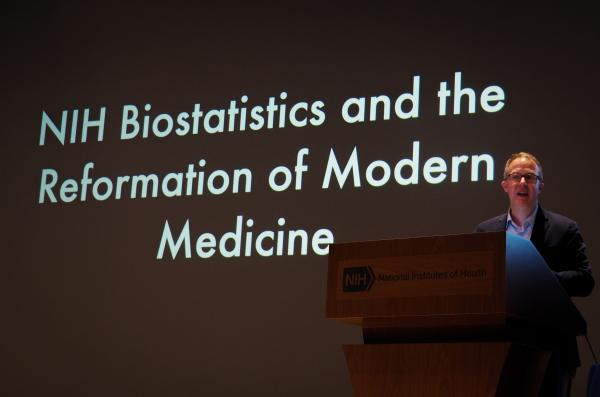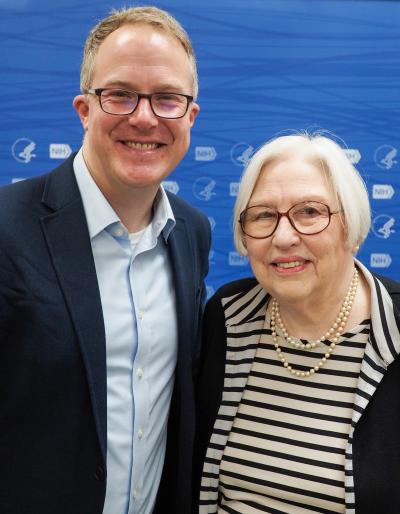From the Annals of NIH History
Harden Lecturer Traces NIH’s Role in Statistics in the Transformation of Clinical Medicine
BY KRIS HEITMAN, ONHM

CREDIT: SAINT RIEWESTAHL, ONHM
Phillips delivered the 2024 Victoria A. Harden Lecture in NIH History at the annual Research Festival, held each fall in Bethesda.
In the mid- to late 20th century, clinical medicine underwent a series of major shifts due to innovations in statistical methods and concepts. Christopher Phillips, professor of history at Carnegie Mellon University (Pittsburgh), discussed several of NIH’s major contributions in the second annual Victoria A. Harden Lecture in NIH History, titled “NIH Biostatistics and the Reformation of Modern Medicine.” Phillips took audience members through a journey of several crucial mathematical innovations at the NIH.
Phillips began by noting that “quantification changes how we think about” both the clinical presentation of disease and potential therapeutic interventions. NIH’s early statisticians applied methods from other fields to medical questions, he explained, often to establish rigorous, predictive ways of reasoning about a disease—an area that traditional epidemiology and public-health statistics had not been able to address satisfactorily. By the 1980s, medicine could consider individual patients as “collections of biomarkers” that could be subjected to a purely quantitative risk assessment based on population-level studies.
In the 1940s, Public Health Service leadership asked sociologist Harold Dorn to establish a group of statistical consultants at NCI. Although Dorn’s group was small at first and most of its members came from outside of medicine, it rapidly became the best-connected network in cancer research, Phillips said. By the 1960s, the group regularly contributed to studies throughout the United States and played a central role in building scientific consensus. Through intramural fellowships, they also provided well-trained biostatisticians to universities that sought innovative analysis for their NIH extramural grants.
Dorn’s consultants began working with the NIH-funded Framingham Heart Study in the late 1940s. Faced with an impressive stream of data, they asked how they could move beyond the initial statistical associations and, in the 1960s, to frame and to answer new, clinically meaningful questions about the progression of heart disease. NHLBI statistician Jerry Cornfield realized that, by thinking of study factors as “doses,” he and his colleagues could predict what “dose” of factors would likely result in heart disease. Indeed, by treating individuals as aggregates of numerical data, they could eventually identify effective interventions for that group of variables. This strategy became an important addition to the usual experimental method of trying physical treatments on groups of patients and comparing outcomes.
In the early 1960s, while developing methods for the first Report of the U.S. Surgeon General’s Advisory Committee on Smoking and Health (1964), Harvard statistician William Cochran explicitly drew on work by Dorn and Cornfield. Phillips emphasized the similarities between their reasoning about cancer and well-established efforts to prevent industrial harms. Rather than pursuing causal relations in the way epidemiologists traditionally had, he said Dorn, Cornfield, and Cochran asked whether harms observed could be statistically foreseen from the data in hand.
Phillips drew a third example from the work of Nathan Mantel, a colleague of Cornfield’s who joined an NCI effort to establish an acceptable level of cancer-causing herbicides in the U.S. food supply. NCI statisticians of the 1940s had worked on a similar problem: After early chemotherapies and radiation therapies presented a mix of benefits and harms, the research challenge was to determine the most effective dose with an acceptable risk of harm. Mantel and his NCI collaborator Ray Bryan recognized that pesticides would also present risks and benefits for human health, so they developed methods to compute a “virtual safe dose” for whatever level of risk the government decided was acceptable.

CREDIT: SAINT RIEWESTAHL, ONHM
Christopher Phillips and Victoria Harden
Phillips closed by noting that statistics, particularly within the U.S. government, has long drawn a much more diverse, inclusive set of workers. Though the work often required clerical and service skills typical of what was then considered so called “women’s work,” it also presented opportunities in technical fields to those employees. Starting with Depression-era work programs, the United States government had become much more open than academia to hiring women, people of Jewish faith or descent, and people of color into statistical and mathematical jobs.
Watch the 2024 Victoria A. Harden Lecture in NIH History on NIH VideoCast.
The Victoria A. Harden Lecture in NIH History is presented annually by the Office of NIH History and Stetten Museum (ONHM) in honor of its founding director, Victoria Harden. This year’s lecture took place on September 24 during the 2024 NIH Research Festival.
Kris Heitman is deputy director and senior historian in the Office of NIH History and Stetten Museum.
This page was last updated on Tuesday, November 5, 2024
